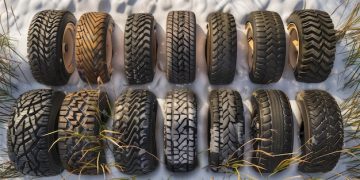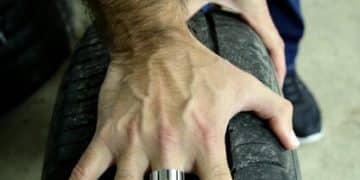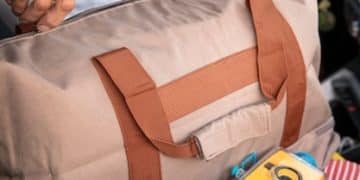Emergency roadside kit essentials: what you need

An emergency roadside kit should include essential tools like jumper cables, a tire jack, a first aid kit, water, and snacks to ensure preparedness for unexpected vehicle troubles.
When it comes to travel, having an emergency roadside kit essentials is vital for every driver. Imagine being stuck on a deserted road without the right tools. This guide will help you prepare.
Understanding the importance of a roadside kit
In any journey, understanding the importance of a roadside kit cannot be overstated. It serves as your lifeline when unexpected problems arise. Whether you’re on a long road trip or a quick drive across town, having a well-prepared kit ensures you are equipped to handle emergencies.
Why a roadside kit is essential
A roadside kit is more than just a collection of tools; it’s a safeguard against the unexpected. Imagine getting a flat tire in the middle of nowhere or facing a sudden breakdown. These situations can be overwhelming, but with the right supplies, you can manage them effectively.
- Peace of mind: Knowing you have the essentials can reduce anxiety during travel.
- Safety: Items like flares and reflective triangles can help keep you visible to other drivers.
- Efficiency: Having the right tools can save you time and money when dealing with roadside issues.
Moreover, a comprehensive kit can save lives. In case of more serious accidents, having basic first aid supplies can be crucial. Always make sure to check your kit regularly, especially before long trips. This ensures you have everything you need and that items have not expired. Keep in mind that different scenarios might require different supplies, so tailor your kit to suit your travel needs and environment.
What to include in your kit
When assembling your roadside kit, consider including tools like jumper cables, a spare tire, and a tire jack. Additionally, it’s wise to have a flashlight, extra batteries, and a multi-tool for unexpected repairs. Don’t forget to pack a first aid kit and bottled water, which can be essential during long stretches on the road.
Investing in a quality roadside kit means investing in your safety. Regularly update your contents based on the season and your driving habits. Drive safely.
Essential tools and items for your kit

When creating a roadside kit, selecting the right essential tools and items is crucial for staying prepared during emergencies. Having these supplies on hand can make a significant difference when faced with unexpected situations.
Key tools to include
Consider including basic tools like a tire jack, a spare tire, and jumper cables. These items are invaluable when it comes to common vehicle problems.
- Tire jack: Useful for changing a flat tire quickly.
- Jumper cables: Essential for restarting a dead battery.
- Multi-tool: Versatile for various minor repairs and adjustments.
Along with tools, it’s wise to have safety items in your kit. These can ensure your well-being if you find yourself stranded. A first aid kit is a must, as it allows you to tend to minor injuries until help arrives. Flare guns or reflective triangles can warn other drivers of your presence, keeping you safe on the roadside.
Additional supplies for your kit
Don’t forget other essential supplies that could be of great help in emergencies. Water and non-perishable snacks can keep you nourished while you wait for assistance. A flashlight with extra batteries ensures you can see and be seen during late-night events.
- First aid supplies: Band-aids, antiseptics, and pain relievers.
- Bottled water: Hydration is key during any wait.
- Portable phone charger: Keep your phone charged for communication.
Having a basic toolkit that includes all these elements can help prepare you for various situations while on the road. Remember to check your kit regularly to make sure everything is in working order and that supplies are not expired.
How to customize your roadside kit
Customizing your roadside kit is essential to ensure it meets your specific needs and preferences. Not every driver faces the same challenges, so tailoring your kit can provide greater peace of mind.
Assess your driving habits
Start by evaluating the types of trips you usually take. If you often drive in remote areas, your kit should include items that address potential problems you might encounter, such as extra food and water. For city driving, consider tools that help with minor repairs and protection against accidents.
- Remote areas: Include a map, extra water, and snacks.
- City driving: Focus on tools for quick fixes, like tire repair kits.
- Seasonal changes: Customize based on weather, like blankets for winter.
Maintaining awareness of your car’s condition is also crucial. For instance, if your vehicle has certain weaknesses or issues, you should take specific tools or parts that address these potential problems. This proactive measure can save you time and stress on the road.
Essential items to tailor
Consider including personalized items that reflect your unique needs. If you have children, a few toys or games can keep them entertained during long waits. For those who like to travel with pets, pack items such as water bowls or pet first aid supplies.
- For families: Include activities to occupy children.
- For pets: Incorporate pet food, water bowls, and leashes.
- Special tools: If you’re handy, add tools specific to repairs you often tackle.
Finally, ensure your roadside kit is organized for easy access. Invest in a sturdy bag or container to keep everything contained and ready for any situation. A well-organized kit helps you find what you need quickly, which can be essential during an emergency.
Tips for maintaining your roadside kit

Maintaining your roadside kit is essential to ensure it is ready for use in emergencies. Regular checks help keep your supplies effective and functional, preventing frustration when you need them most.
Conduct regular inspections
Set a schedule to review your kit at least twice a year. Look for expired items, make sure tools are in good condition, and replace anything that is broken or worn. This helps to ensure that everything is safe and prepared.
- Check first aid supplies: Ensure bandages, antiseptics, and medications have not expired.
- Inspect tools: Look for rust or damage on items like jacks and wrenches.
- Update food and water: Replace old snacks and check the water supply regularly.
A key part of maintenance is organization. Keep your kit clean and organized, with all items stored in a designated container. Using clear bags or compartments can help you find what you need quickly. Labels can also make it easier to ensure everything is in its proper place.
Adapt to seasonal needs
As seasons change, your roadside kit may need to adapt. For example, during winter, include items that help with snow and ice, like a shovel and ice scraper. In summer, consider adding sunscreen or mosquito repellant.
- Winter essentials: Add blankets, shovels, and tire traction aids.
- Summer supplies: Include water, sunblock, and hydration packs.
- Weather check: Always check the forecast before long trips and adjust your kit accordingly.
After long trips, review what was helpful and what was not. Adjust your kit based on lessons learned from past experiences so you can improve your preparation for future needs.
FAQ – Frequently Asked Questions about Roadside Kits
What essential items should be in my roadside kit?
Your roadside kit should include jumper cables, a tire jack, a first aid kit, water, snacks, and reflective triangles for safety.
How often should I check my roadside kit?
You should inspect your roadside kit at least twice a year to ensure all items are in good condition and not expired.
Can I customize my roadside kit based on my needs?
Yes, you can customize your kit by adding items specific to your driving habits, such as tools for DIY repairs or additional supplies for pets.
Why is it important to maintain my roadside kit?
Maintaining your roadside kit ensures you are prepared for emergencies, keeping all essential items functional and ready for use.





